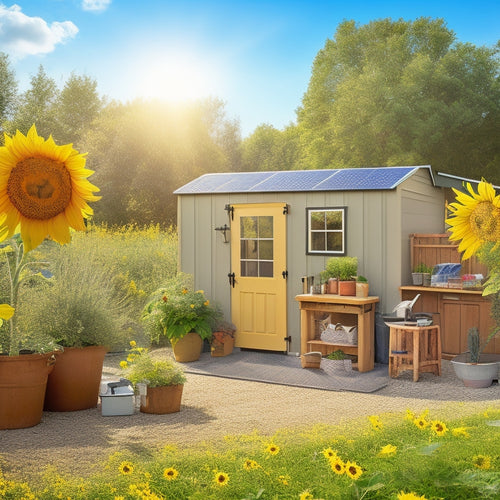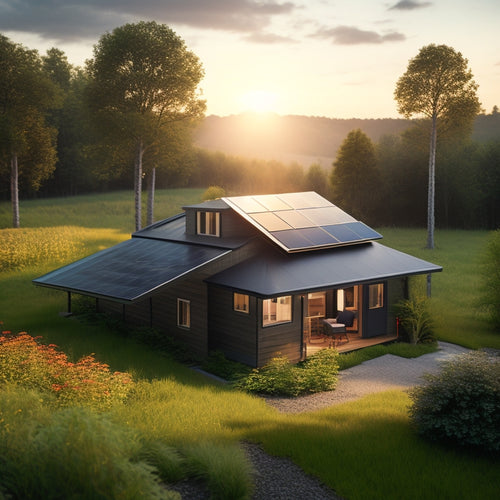
Diy Solar Panels for Home
Share
You're evaluating DIY solar panels for your home, a smart move that can greatly lower your energy costs by 50% or more and reduce your reliance on the grid. By installing a DIY solar kit, you'll overcome high installation costs and start saving on your monthly electricity bills. You'll also reduce your carbon footprint, as switching to solar power reduces energy consumption and greenhouse gas emissions. To maximize the benefits, you'll need to assess your roof's shading, identify areas of energy waste, and optimize your energy usage. Now, let's take a closer look at the key factors to evaluate for a successful DIY solar panel installation.
The Essentials
- DIY solar panels can significantly lower energy costs by reducing monthly electricity bills by 50% or more.
- Installing DIY solar kits can overcome high installation costs, and solar incentives like tax credits can offset expenses.
- High-efficiency photovoltaic cells in DIY solar panels maximize energy conversion rates, contributing to sustainability efforts and reducing carbon footprint.
- Proper installation considerations, such as roof obstruction analysis and shade pattern identification, ensure optimal solar panel placement and energy output.
- Reducing energy consumption through energy audits, efficient appliances, and smart power management strategies increases the effectiveness of DIY solar panels for homes.
Save Money on Bills
By switching to DIY solar panels, you'll greatly cut energy costs and reduce your reliance on the grid.
With a DIY solar kit, you can overcome common challenges such as high installation costs and complexity in determining the right equipment for your specific needs off-grid systems.
This means you'll pay less for electricity each month, freeing up more money in your budget for other expenses.
With solar panels, you can expect to save up to 50% or more on your electricity bills, depending on your energy usage and location.
Cut Energy Costs
Every month, hundreds of dollars flow out of your pocket to pay for electricity bills, a significant chunk of which goes towards powering your home's appliances and lighting. But what if you could cut those costs and redirect that money towards more important things? With DIY solar panels, you can.
To start, consider conducting an energy audit to identify areas in your home where energy is being wasted. This will help you pinpoint opportunities to make changes and reduce your energy consumption. Additionally, take advantage of solar incentives, such as tax credits and rebates, to offset the cost of installing solar panels.
Here's a breakdown of how DIY solar panels can help you cut energy costs:
| Energy Cost | Savings with DIY Solar |
|---|---|
| Electricity bills | 50-70% reduction |
| Appliance energy consumption | 20-30% reduction |
| Lighting energy consumption | 15-25% reduction |
| HVAC energy consumption | 10-20% reduction |
| Water heating energy consumption | 5-15% reduction |
Reduce Electricity Bills
About 70% of your monthly electricity bills can be attributed to powering your home's appliances and lighting, which is a significant expense.
By installing DIY solar panels, you'll reduce your reliance on the grid and lower your electricity bills. A well-designed solar panel installation can save you hundreds of dollars per year, freeing up your hard-earned money for more important things.
With a DIY solar panel kit, you can overcome common barriers to renewable energy, such as high electricity bills and limited grid connection in remote areas. By taking control of your energy production, you'll be well on your way to energy independence.
To maximize your savings, it's important to monitor your energy usage.
Energy monitoring systems track your energy production and consumption in real-time, helping you identify areas for improvement. With this data, you can optimize your energy usage, reducing waste and further lowering your bills.
Renewable Energy Independence
You're taking a significant step towards renewable energy independence by utilizing green energy sources like solar power.
With a home solar power system, you can generate your own renewable energy and save on utility bills residential energy solutions.
By installing DIY solar panels, you'll be able to power your home with clean energy, reducing your reliance on fossil fuels and lowering your carbon footprint.
This shift won't only benefit the environment but also provide you with a sense of energy security and independence.
Green Energy Sources
Three decades of rapid technological advancements have altered the renewable energy environment, making it more feasible for homeowners to achieve renewable energy independence. You're no longer limited to relying on traditional fossil fuels to power your home. With the rise of green energy sources, you can reduce your environmental impact and enjoy the benefits of sustainable living.
Green energy sources offer a cleaner, more efficient alternative to traditional energy sources. Here's a comparison of some popular options:
| Green Energy Source | Advantages |
|---|---|
| Solar Energy | Zero emissions, abundant resource, decreasing cost |
| Wind Energy | Low operating costs, scalable, reduces carbon footprint |
| Hydro Energy | High energy conversion rate, reliable, renewable |
| Geothermal Energy | Consistent energy supply, low emissions, widespread availability |
Powering Your Home
Achieving renewable energy independence for your home is now a tangible reality. With the increasing popularity of solar energy systems, you can break free from the grid and power your home sustainably. By opting for a DIY installation, you'll not only reduce your carbon footprint but also save on energy costs.
When it comes to powering your home, solar energy systems are an attractive option. They're clean, quiet, and produce no emissions. With a well-designed system, you can generate enough electricity to power your appliances, lights, and even your heating and cooling systems.
By utilizing the energy from the sun, you'll reduce your reliance on fossil fuels and lower your energy bills.
A DIY installation allows you to take control of your energy needs. You can design and install a system that meets your specific requirements, ensuring maximum efficiency and cost-effectiveness.
With the right tools and knowledge, you can achieve renewable energy independence and enjoy the freedom that comes with it.
High-Efficiency Photovoltaic Cells
You'll want to focus on high-efficiency photovoltaic cells that maximize energy conversion rates, which is essential for achieving considerable solar power for homes and reducing your electricity bills.
By investing in high-efficiency cells, you can reduce your carbon footprint and contribute to a more sustainable future.
Two vital factors to reflect on are cell efficiency factors, which determine how effectively your cells convert sunlight into electricity, and advanced PV materials, which can greatly enhance your panel's overall performance.
Cell Efficiency Factors
During the fabrication of high-efficiency photovoltaic cells, manufacturers carefully balance multiple cell efficiency factors to enhance energy conversion.
You'll find that different cell types, such as monocrystalline, polycrystalline, and thin-film, have unique characteristics that impact their performance. For instance, monocrystalline cells boast higher efficiencies due to their uniform crystal structure, while polycrystalline cells are more affordable but less efficient.
To achieve peak performance, manufacturers focus on performance optimization techniques, including surface texturing, anti-reflective coatings, and backside passivation.
These techniques enhance light absorption, reduce reflection, and minimize recombination losses, resulting in higher energy yields.
You should also consider the importance of fill factor, open-circuit voltage, and short-circuit current in determining a cell's overall efficiency.
Advanced PV Materials
Researchers are constantly pushing the boundaries of photovoltaic technology, experimenting with advanced PV materials to craft high-efficiency photovoltaic cells that can capture more sunlight and convert it into usable energy.
You're probably familiar with traditional silicon-based cells, but newer materials like perovskite materials and organic photovoltaics are gaining traction. These advanced materials offer improved efficiency and flexibility, enabling the creation of bifacial solar panels that can collect energy from both sides.
Transparent conductors and multi-junction cells are also being developed to maximize energy output. Moreover, innovations in nanostructured coatings and light-trapping techniques can increase energy absorption.
As you consider building your DIY solar panel, it's crucial to keep an eye on these emerging technologies. Additionally, don't forget about solar panel recycling, which will become increasingly important as the industry grows.
Assess Your Roof's Shading
You'll need to conduct a roof obstruction analysis to identify any obstructions that could cast shade on your solar panels. This involves evaluating the presence and location of trees, chimneys, vents, and other roof features that could block sunlight.
Additionally, it's crucial to take into account the impact of seasonal changes on shading patterns, as off-grid energy solutions require careful planning. By understanding how shading affects your solar panels, you can optimize their placement for maximum energy production.
Roof Obstruction Analysis
One of the most critical factors in determining the viability of a DIY solar panel system is evaluating your roof's shading.
As you assess your roof's shading, consider the roof orientation and its impact on sunlight hours. A south-facing roof with minimal obstructions will receive the most sunlight hours, making it an ideal location for solar panels.
You'll want to identify any obstructions, such as trees, chimneys, or skylights, that could cast shadows on your solar panels.
Take note of the time of day and year when these obstructions cast shadows, as this will help you determine the best placement for your solar panels.
Using a shading analysis tool or consulting with a solar expert can help you determine the best placement and angle for your solar panels.
Shade Pattern Identification
Assess your roof's shading by mapping out the shade patterns throughout the day and year. This essential step in your DIY solar panel project helps you identify areas that receive ideal sunlight exposure. Conduct a shade analysis to determine the impact of surrounding structures, trees, and other obstructions on your roof's sunlight exposure.
Take note of the seasonal variations in shade patterns. During the winter, the sun is lower in the sky, casting longer shadows. In contrast, the summer sun is higher, resulting in shorter shadows. Observe how these changes affect the shading on your roof. You can use a sunlight simulator tool or consult with a solar panel professional to get accurate data.
Create a detailed map of your roof's shading, highlighting areas that receive full sun, partial shade, and full shade. This information will help you determine the best placement for your solar panels, ensuring maximum energy output.
Don't overlook this vital step, as it can greatly impact the performance of your DIY solar panel system.
Lower Carbon Footprint Guaranteed
By switching to DIY solar panels, you'll greatly reduce your energy consumption, which is an essential step in lowering your carbon footprint.
This reduction is achieved by utilizing renewable energy from the sun, thereby decreasing your reliance on fossil fuels.
As a result, you'll be producing fewer greenhouse gas emissions, contributing less to climate change.
Reduce Energy Consumption
With energy consumption being a significant contributor to your carbon footprint, reducing it's vital in your expedition towards a more sustainable lifestyle.
You can't just install DIY solar panels and expect to save the planet; you need to optimize your energy usage first. Start by conducting an energy audit to identify areas of inefficiency. Check for air leaks, install LED bulbs, and unplug appliances when not in use. These energy saving tips may seem trivial, but they can make a substantial impact.
Implementing power management strategies is also essential. Consider installing smart plugs or a smart home system to monitor and control your energy usage.
You can also adjust your daily habits, such as doing laundry during off-peak hours or using energy-intensive appliances during the day when your solar panels are producing power.
By reducing your energy consumption, you'll not only lower your carbon footprint but also increase the effectiveness of your DIY solar panels.
Frequently Asked Questions
How Long Does It Take to Install DIY Solar Panels?
You'll typically need 1-3 days for a DIY solar panel installation, depending on the system size and your skillset. Following installation tips, like preparing your roof and electrical connections, will help you stay on track and meet your desired installation timeline.
Can I Build Solar Panels With Recycled Materials?
You can create a homemade solar panel using recycled materials, sourcing components like repurposed solar cells, reclaimed copper wiring, and second-hand glass or plastic frames, reducing waste and energy costs while achieving energy independence.
Are DIY Solar Panels Eligible for Government Incentives?
You're wondering if your DIY project qualifies for government incentives. Yes, you're eligible for incentive programs and tax credits if you meet specific requirements, such as using certified equipment and following local building codes.
Do DIY Solar Panels Void My Roof's Warranty?
Coincidentally, you're not alone in wondering if DIY projects void warranties; when installing solar panels, you'll face roof warranty implications, and if not done correctly, installation risks can lead to costly repairs, so it's crucial to check your roof's warranty terms beforehand.
Can I Sell Excess Energy Back to the Grid?
You can sell excess energy back to the grid through net metering benefits, which allow you to offset your consumption and receive credits; many utilities also offer energy buyback programs, giving you freedom to generate and profit from your own power.
Final Thoughts
By utilizing the power of DIY solar panels, you'll be shining a light on your path to energy independence. With high-efficiency photovoltaic cells, you'll be slashing your energy bills and reducing your carbon footprint. Don't let shading hold you back - assess your roof's potential and take the leap. As you bask in the glow of renewable energy, you'll be illuminating a brighter future for generations to come. Your wallet, and the planet, will thank you.
Related Posts
-

Top Eco-Friendly Camping Equipment for a Sustainable Adventure
When you're camping with the planet in mind, opt for eco-friendly gear like tents made from recycled materials and bi...
-

Building an Emergency Backup Solar Power System in 5 Essential Steps
Building an emergency backup solar power system involves five key steps. First, assess your daily energy needs to ide...
-

Diy Off Grid Solar
By embracing DIY off-grid solar, you can break free from grid dependence, slashing your energy bills by up to 90% and...


